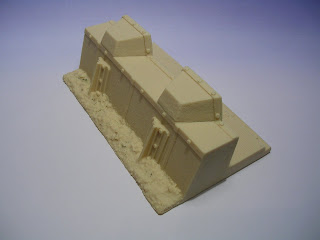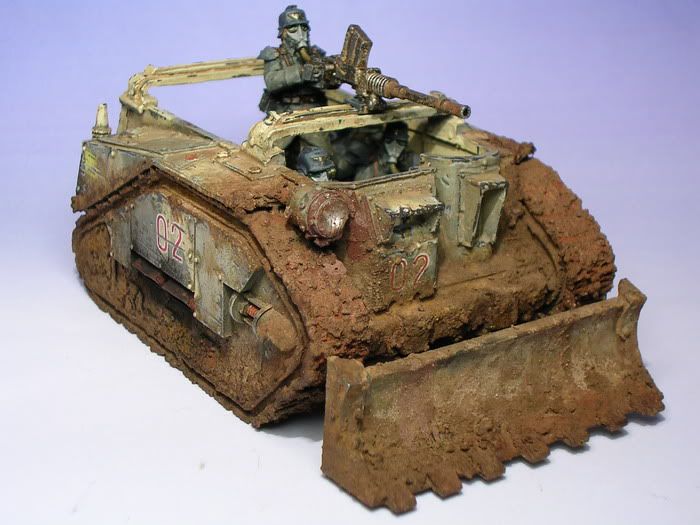(versión en Español)
PART I
PART II
PART III
PART IV
Today, we are going to finish this tutorial. I have also edited previous entries to put the exact paint I used on each stage, so feel free to check them again.
You'll notice that I painted some small areas, like the storm bolter and so. Those are not important enough to enter on details, just put a coat or two of Vallejo Model Color or Humbrol Enamels..
We are going to continue painting all optics (periscope lenses, etc.) on Humbrol Silver #11. Once the enamel is dry, I cover it with Tamiya Clear Blue X23. This is a transparent paint that gives the lenses a natural finish. I let everything dry before going to the next step. I put a drop of Microscale Micro Krystal Klear in a the concave fitting I let express in the model to accommodate a light.
PART I
PART II
PART III
PART IV
Today, we are going to finish this tutorial. I have also edited previous entries to put the exact paint I used on each stage, so feel free to check them again.
You'll notice that I painted some small areas, like the storm bolter and so. Those are not important enough to enter on details, just put a coat or two of Vallejo Model Color or Humbrol Enamels..
We are going to continue painting all optics (periscope lenses, etc.) on Humbrol Silver #11. Once the enamel is dry, I cover it with Tamiya Clear Blue X23. This is a transparent paint that gives the lenses a natural finish. I let everything dry before going to the next step. I put a drop of Microscale Micro Krystal Klear in a the concave fitting I let express in the model to accommodate a light.
 I use again my graphite stick on the tow cable, then I rub it with my finger to burnish it a little.
I use again my graphite stick on the tow cable, then I rub it with my finger to burnish it a little. This is the concave fitting I told you before. Once the Micro Krystal Klear is dry it becomes transparent, it just needs a little varnish coat to look very nice!
This is the concave fitting I told you before. Once the Micro Krystal Klear is dry it becomes transparent, it just needs a little varnish coat to look very nice! You'll notice that I not use the common technique used by W40K modelers of painting by hand gemlike reflects. I thought about it and decided that being this model a mix of "traditional" modeling techniques applied to 40K, I would use something different for the optics.
You'll notice that I not use the common technique used by W40K modelers of painting by hand gemlike reflects. I thought about it and decided that being this model a mix of "traditional" modeling techniques applied to 40K, I would use something different for the optics. Now we are going to use another technique based on pigments. I do a very diluted mix of MIG pigments Copper Rust P26 and Ashes White P22 on alcohol.
Now we are going to use another technique based on pigments. I do a very diluted mix of MIG pigments Copper Rust P26 and Ashes White P22 on alcohol.I lightly apply this pigment suspension on alcohol to some selected areas. Once dry, the pigments will show, giving some interesting effects. Look at the rusted area up to the center and the tow cable.
 As you can imagine, putting alcohol over acrylics is risky, so pay attention to not add too much. The paint will soft under the effect of the alcohol, so be careful on where do you place your fingers! See below to see what happened to me...
As you can imagine, putting alcohol over acrylics is risky, so pay attention to not add too much. The paint will soft under the effect of the alcohol, so be careful on where do you place your fingers! See below to see what happened to me... No problem, we'll fix it later adding mud and dust. I add now some rust coloured pigment mix I had laying around to give the problematic area a darker shade.
No problem, we'll fix it later adding mud and dust. I add now some rust coloured pigment mix I had laying around to give the problematic area a darker shade. As the tank is nearly finished, I am going to paint the ammunition boxes. I fix them on a temporary base and paint them by brush with enamels. I used Humbrol #34, #94 and Revell #65.
As the tank is nearly finished, I am going to paint the ammunition boxes. I fix them on a temporary base and paint them by brush with enamels. I used Humbrol #34, #94 and Revell #65.Once they are dry (2 hours at least), I give them an oil wash of Burnt sienna
Once the wash is dry (overnight), I add MIG pigment P230, Old Rust diluted in alcohol to further weather them.
 I glue them on place...
I glue them on place... ...and prepare to move on.
...and prepare to move on. The effect is too exaggerated, but we are going to blend it adding dust.
The effect is too exaggerated, but we are going to blend it adding dust. The effect is very subtle, but it will help to fix the dust in next stage.
The effect is very subtle, but it will help to fix the dust in next stage. I now choose MIG Pigments P28 Europe Dust and P33 Dark Mud.
I now choose MIG Pigments P28 Europe Dust and P33 Dark Mud. I add them dry, with the help of a brush, forcing them to the recesses. I put the darker shade in the parts that are hidden. The lighter shade will be placed in the open areas. It is important to not put dust in the areas used by the crew to access the vehicle.
I add them dry, with the help of a brush, forcing them to the recesses. I put the darker shade in the parts that are hidden. The lighter shade will be placed in the open areas. It is important to not put dust in the areas used by the crew to access the vehicle. Once the pigment is in place, we add some drops of turpentine (I strongly recommend you odourless turpentine. I used Talens 089 Odourless White Spirit) to fix it in place.
Once the pigment is in place, we add some drops of turpentine (I strongly recommend you odourless turpentine. I used Talens 089 Odourless White Spirit) to fix it in place. Once dry, I used my finger to remove dust from some areas. This is how it looks now.
Once dry, I used my finger to remove dust from some areas. This is how it looks now. Now, we recover the mud mix we did in PART III and add a little water.
Now, we recover the mud mix we did in PART III and add a little water. Using a hard bristle brush, we can blow compressed air with the help of an airbrush to do some mud splashes (you better try it before in a piece of card!).
Using a hard bristle brush, we can blow compressed air with the help of an airbrush to do some mud splashes (you better try it before in a piece of card!). Time to add some dry P23 Black Smoke pigment to the engine exhausts...
Time to add some dry P23 Black Smoke pigment to the engine exhausts... ...and to the muzzle brake.
...and to the muzzle brake. Finally! The last stage!
Finally! The last stage!I do a mix of Humbrol Gloss Varnish, Black oil colour and white spirit. I'll use this mix to carefully paint oil and gas (promethium, of course) spills.
 I also added to the turret ring.
I also added to the turret ring. And sparingly to some points on the tracks.
And sparingly to some points on the tracks. Now it's time to look at you model and eliminate excess dusting with a little cotton and turpentine.
Now it's time to look at you model and eliminate excess dusting with a little cotton and turpentine. Officially finished!
Officially finished!

 I hope you have enjoyed this tutorial as much as I did.
I hope you have enjoyed this tutorial as much as I did.See you next soon with more ideas!















